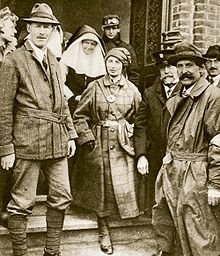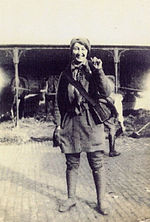- Dorothie Feilding
-
Lady Dorothie Feilding 
Recently decorated with the Order of Léopold II: from The Illustrated War News, Feb. 1915Born 6 October 1889
Newnham Paddox, WarwickshireDied 24 October 1935 (aged 46)
Mooresfort House, Tipperary, IrelandEducation Convent of the Assumption, Paris Years active Sept 1914–June 1917 Known for being the first woman to be awarded the:
Military Medal (1916)
Also received:
1914 Star
Croix de Guerre (1915)
Order of Léopold II (1915)Relatives Rudolph Feilding, 9th Earl of Denbigh
Henry FieldingProfession Nurse, Ambulance Driver Institutions Rugby Hospital
Munro Ambulance CorpsLady Dorothie Mary Evelyn Feilding-Moore (aka "Dot" Feilding), better known as Dorothie Feilding, MM, CdeG, OLII, (6 October 1889–24 October 1935) was a British heiress who shunned her aristocratic background to become a highly decorated volunteer nurse and ambulance driver on the Western Front during World War I. She was the first woman to be awarded the Military Medal for bravery in the field.[1][2][3][4] She also received the 1914 Star,[5] the Croix de guerre from the French and the Order of Léopold II from the Belgians for services to their wounded.[6]
Contents
Early life
Born on October 6, 1889 to Rudolph Feilding, 9th Earl of Denbigh and the Countess of Denbigh, Cecilia Mary Feilding (née Clifford), Feilding was one of ten children, three boys and seven girls. She was a distant relative of Henry Fielding, the author of "Tom Jones". As a child she was educated at home at Newnham Paddox, Monks Kirby, Warwickshire, and at the Convent of the Assumption in Paris, where she became fluent in French. She made her debut in May 1908 at the age of 18, being presented to the King and Queen of England by her mother.
World War I
Like many of her siblings, Feilding felt the need to do her part when war broke out. Three of her sisters, Lady Clare, Lady Elizabeth ("Bettie"), and Lady Victoria would serve, as well as three brothers: Major Rudolph, Viscount Feilding, Coldstream Guards, who survived the war; Lieutenant-Commander the Hon. Hugh Feilding, Royal Navy, killed in action on 31 May 1916 at the Battle of Jutland; and Captain the Hon. Henry Feilding, also Coldstream Guards, who would die on 9 October 1917 from wounds received in action in Flanders just three months after his sister had left.
In September 1914, after a short training course at Rugby Hospital, Feilding traveled to the Western Front in Belgium where she began driving ambulances for the Munro Ambulance Corps (founded by Dr. Hector Munro), an all-volunteer unit which included May Sinclair, Elsie Knocker and Mairi Chisholm.[7] This corps, comprising a convoy of motor ambulances donated by the British Red Cross, consisted of transporting wounded men from front line positions between Nieuport and Dixmude to the hospitals at Furnes.[8][9] Though she was from a privileged upbringing Feilding had an easy demeanor that transcended social boundaries, one that endeared her to all that she came in to contact with whether royalty or the ordinary fighting man. It was reported that her 'five o'clock teas' among the ruins of Furnes gained great fame among the Belgian officers and enlisted men stationed there.[10]
Feilding's heroism was such that her ambulance work at Dixmude was recognized in a 'special order of the day' issued on 31 December 1914 by French Rear-Admiral Pierre Ronarc'h, commanding the Fusiliers Marins for which she subsequently received the French Croix de Guerre (bronze star).[6] In 1916, Commander Henry Crosby Halahan, RN, Officer Commanding Royal Naval Siege Guns, wrote the following letter of recommendation to Prince Alexander of Teck, head of the British Military Mission in Belgium:
"I venture to submit that Lady Dorothie Feilding should in like manner be rewarded. The circumstances are peculiar in that, this being an isolated Unit, no Medical organization existed for clearing casualties other than this voluntary one and owing to indifferent means of communication etc, it was necessary for the Ambulance to be in close touch with the guns when in action. (She) was thus frequently exposed to risks which probably no other woman has undergone. She has always displayed a devotion to duty and contempt of danger which has been a source of admiration to all. I speak only of her work with the Naval Siege Guns, but your Serene Highness is also aware of her devoted services to the Belgian Army and to the French - notably to the Brigade des Marins."
This citation ultimately resulted in Feilding becoming the first woman to be awarded the Military Medal for bravery on the 1 September 1916 as notified in the London Gazette.[11][12] Five days later she was decorated with the medal by King George V himself at Windsor Castle. She was also decorated by King Albert I with the Belgian Order of Léopold II, Knights Cross (with palm)[10] for service to his country's wounded. In her letters,[13] which she wrote home to Newnham Paddox almost daily, Feilding would reflect on the tragedy and horror of war and also the problems of being a woman at the front contending with gossip, shells, funding, lice (which forced many of the nurses to cut their hair short), vehicle maintenance and inconvenient marriage proposals. After two years at the front she began to look pale and tired.[14] She served with the corps in Flanders until June 1917 when she returned home to get married. On 5 July 1917, Feilding wed Captain Charles Joseph Henry O'Hara Moore, MC, of Mooresfort, Tipperary. She moved to Warley, Middlesex where her husband was stationed in the 2nd battalion, Irish Guards. After a brief honeymoon period, Feilding was back behind the wheel of an ambulance, ferrying the wounded around London.
Post-War years
After the war, the couple lived most of the year at his ancestral home, Mooresfort House in South Tipperary. They had four daughters (Ruth, Celia, Edith and June) and one son (Arthur). Feilding became an active member of the British Legion as well as being President of the Tipperary Jubilee Nursing Association and the local Agricultural Show Society. She had always been a keen huntswoman and this continued in Ireland where she was a regular feature at hunt meets, especially the Scarteen Hunt. In 1935, the Irish Times stated she had been "prominently associated with the Scarteen Hunt to the success of which her great organizing powers in no small degree contributed." [13] In no small measure, these powers had been honed during her time with the Munro Corps. Her husband had a stud at Mooresfort and the couple regularly attended race meetings in Ireland and England.
Death
Feilding died of heart failure in Tipperary on 24 October 1935 at the age of 46. She was brought back home to Warwickshire and buried on 27 October in the family plot at the Monks Kirby Roman Catholic cemetery.
Awards and decorations
 Military Medal
Military Medal Knight of the Order of Léopold II with Palm
Knight of the Order of Léopold II with Palm French Croix de Guerre
French Croix de Guerre 1914 Star
1914 StarSee also
- Elsie Knocker
- Mairi Chisholm
- May Sinclair
- Albert I of Belgium
- Alexander Cambridge, 1st Earl of Athlone
- Western Front
Bibliography
- Atkinson, Diane. Elsie and Mairi Go to War: Two Extraordinary Women on the Western Front. Cornerstone. (2009)
- Hallam, Andrew & Nicola. Lady Under Fire on the Western Front: The Great War Letters of Lady Dorothie Feilding MM. Pen & Sword Military. (2010)
- Mitton, Geraldine Edith, T'Sercles, Baroness Elsie, Chisholm, Mairi. The Cellar-House of Pervyse : A Tale of Uncommon Things from the Journals and Letters of the Baroness T'Serclaes and Mairi Chisholm. A.C. Black. (1917)
- T'Sercles, Elsie Baroness de. Flanders and Other Fields. Harrap. (1964)
External links
- Online text
- Elsie And Mairi Go To War: Two Extraordinary Women On The Western Front (2009) by Diane Atkinson at Kobo
- The Cellar-House of Pervyse (1917) at Internet Archive.
- Seeking Wounded on the Battle Front (1914) at New York Times
- Part II: Furnes (1918) from 'A War Nurse's Diary; Sketches from a Belgian Field Hospital'
- Women in the War (1914) from the magazine 'T.P.'s Great Deeds of the Great War' at greatwardifferent.com
- A Surgeon in Belgium (1915) by Henry Sessions Souttar at Google Books
- A War Nurse's Diary (1917) at greatwardifferent.com
- Women in Print (1917) from The Evening Post
- Braves Death Daily (1915) from Grey River Argus
- Some of My Experiences in the Great War (2009) by E. Ashmead-Bartlet at Google Books
- Current History of the European War, Vol 1, Issue 4 (1915) at the New York Times
- Digital archive
- The Nurses Story: Tending the Wounded at the Front at National Library of Scotland
- "museum fusiliers marins France"
References
- ^ The Encyclopædia Britannica: Volume III (1920)
- ^ New Zealand Evening Post (1917) from The National Library of New Zealand
- ^ 1911encyclopedia.org
- ^ Westley, F. C., The Spectator, (1919) Issues 4723-4748
- ^ thepeerage.com
- ^ a b American Journal of Nursing, Volume 17, Issue 1, p. 144
- ^ The New York Times Jan. 14, 1917
- ^ Foster, R. and Cluley, C. (2000). Warwickshire Women: A Guide to Sources in the Warwickshire County Record Office Warks. CRO, Feilding Papers
- ^ Leslie, J.H. (1919). An Historical Roll (with Portraits) of Those Women of The British Empire to Whom the Military Medal has been Awarded During The Great War, 1914–18, pt 1
- ^ a b British Journal of Nursing, Feb. 6, 1915; p. 110
- ^ The National Archives: Feilding Family of Newnham Paddox: CR 2017/C329 - CR 2017/C1388
- ^ Salmon, Edward (1917). The British Dominions Year Book
- ^ a b Hallam, Andrew and Hallam, Nicola (2010). Lady Under Fire on the Western Front: The Great War Letters of Lady Dorothie Feilding MM. Pen & Sword Military
- ^ Butler, Patrick Richard (1920). A Galloper at Ypres: and Some Subsequent Adventures.T. Fisher Unwin. London. p. 168 (ISBN 0559519699/0-559-51969-9)
Categories:- 1889 births
- 1935 deaths
- People from Warwickshire (before 1974)
- English Roman Catholics
- Female wartime nurses
- British women in World War I
- Recipients of the Military Medal
- Recipients of the Croix de Guerre (France)
- Knights of the Order of Leopold II
Wikimedia Foundation. 2010.

